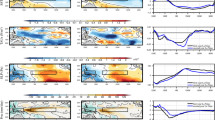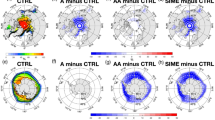Abstract
The results of numerical experiments using a coupled model of water and ice circulation from September 1979 to December 2019 aimed at studying the interannual variability of the ice balance in the Arctic Ocean (AO) are considered. These results have made it possible to analyze the geographical features of the processes of ice formation and melting in the AO and identify the key regions that determine the volume of ice in the ocean. It is established that most ice is formed in the waters of the Siberian seas, and the most intense melting occurs in the North European Basin, where the ice transported by the Transpolar Drift Stream through the Fram Strait enters the relatively warm water of the Greenland Sea, heated by the North Atlantic Current. The formation of the absolute minimum of ice coverage in 2012 was caused by the anomalous position of the anticyclonic hydrological cycle located much closer to the Canadian coast. This resulted in the fact that only a small part of the ice formed in the Siberian seas was involved in a weak circulation, while most of the ice in the stream of the Transpolar Drift Stream was transported through the Fram Strait to the Greenland Sea. A statistical analysis of the results of numerical experiments demonstrated that the trend towards a decrease in the volume of ice in the AO is primarily determined by global warming, and dynamic forcing exerts significant effect on local extremes. A coupled model of circulation of water and ice was used to study the variability of ice balance in the AO. The results of special numerical experiments from September 1979 to December 2019 made it possible to establish some geographical features of the processes of ice formation and melting. Statistical analysis of the results showed that the trend towards a decrease in the volume of ice in the AO is determined primarily by global warming, while local extremes are strongly influenced by dynamic forcing.





Similar content being viewed by others
REFERENCES
Aleksandrov, E.I., Andronov, P.Yu., Blinovskaya, Ya.Yu., Bloshkina, E.V., Bryazgin, N.N., Grinfeld, Yu.S., Datskii, A.V., Dement’ev, A.A., Dymov, V.I., Zhuravel, V.I., Karklin, V.P., Konyukhov, N.B., Kuznetsova, D.M., Kulakov, M.Yu., Makhotin, M.S., et al., Ekosistemy Beringova proliva i faktory antropogennogo vozdeistviya (Ecosystems of the Bering Strait and Anthropogenic Impact Factors), Moscow: WWF-Russia, 2019.
Alekseeva, T.A., Serovetnikov, S.S., Frolov, S.V., and Sokolov, V.T., Ice conditions of the cruise of the nuclear-powered icebreaker “50 let Pobedy” along the Franz Josef Land–North Pole route in the summer of 2018, Ross. Arkt., 2018, vol. 2, pp. 31–40.
Atlas gidrometeorologicheskikh i ledovykh uslovii morei Rossiiskoi Arktiki (Atlas of Hydrometeorological and Ice Conditions of the Russian Arctic Seas), Pavlov, V.A., Verbitskaya, O.A., Mironov, E.U., Tarasov, P.A., and Kornishin, K.A., Eds., Moscow: Neftyanoe khozyaistvo, 2015.
Bekryaev, R.V., Polyakov, I.V., and Alexeev, V.A., Role of polar amplification in long-term surface air temperature variations and modern Arctic warming, J. Clim., 2010, vol. 23, no. 14, pp. 3888–3906. https://doi.org/10.1175/2010JCLI3297.1
Gerdes, R. and Koberle, C., Comparison of Arctic sea ice thickness variability in IPCC Climate of the 20th century experiments and in ocean-sea ice hindcasts, J. Geophys. Res., 2007, vol. 112, p. C04S13. https://doi.org/10.1029/2006JC003616
Holland, M.M., Serreze, M.C., and Stroeve, J., The sea ice mass budget of the Arctic and its future change as simulated by coupled climate models, Clim. Dyn., 2010, vol. 34, pp. 185–200. https://nsidc.org/arcticseaicenews/. https://www.aari.ru/main.php?lg=0&id=94.https://doi.org/10.1007/s00382-008-0493-4
Hunke, E.C. and Dukowicz, J.K., An elastic–viscous–plastic model for sea ice dynamics, J. Phys. Oceanogr., 1997, vol. 27, pp. 1849–1867. https://doi.org/10.1175/1520-0485(1997)027<1849:AEVPMF>2.0.CO;2
Ivanov, B.V. and Makshtas, A.P., Quasi-stationary zero-dimensional model of the Arctic ice, Tr. Arkt. Antarkt. Nauchno-Issled. Inst., 1990, vol. 420, pp. 18–31.
Ivanov, V., Alexeev, G.V., Koldunov, N.V., Repina, I.A., Sandoe, A.B., Smedsrud, L.H., and Smirnov, A., Arctic Ocean heat impact on regional ice decay: A suggested positive feedback, J. Phys. Oceanogr., 2016, vol. 46, pp. 1437–1456. https://doi.org/10.1175/JPO-D-15-0144.1
Johnson, M., Proshutinsky, A., Aksenov, E., Nguyen, A.T., Lindsay, R., Haas, C., Zhang, J., Diansky, N., Kwok, R., Maslowski, W., Hakkinen, S., Ashik, I., and de Cuevas, B., Evaluation of Arctic sea ice thickness simulated by Arctic Ocean Model Intercomparison Project models, J. Geophys. Res., 2012, vol. 117, p. C00D13. https://doi.org/10.1029/2011JC007257
Kauker, F., Gerdes, R., Karcher, M., Koberle, C., and Lieser, J.L., Variability of Arctic and North Atlantic sea ice: A combined analysis of model results and observations from 1978 to 2001, J. Geophys. Res., 2003, vol. 108, no. C6, p. 3182. https://doi.org/10.1029/2002JC001573
Koldunov, N.V., Köhl, A., and Stammer, D., Properties of adjoint sea ice sensitivities to atmospheric forcing and implications for the causes of the long term trend of Arctic sea ice, Clim. Dyn., 2013, vol. 41, pp. 227–241. https://doi.org/10.1007/s00382-013-1816-7
Kulakov, M.Yu. and Demchev, D.M., Simulation of iceberg drift as a component of ice monitoring in the West Arctic, Russ. Meteorol. Hydrol., 2015, vol. 40, no. 12, pp. 807–813.
Kulakov, M.Yu. and Makshtas, A.P., The role of ice drift in the formation of the ice cover of the Arctic Ocean at the beginning of the XXI century, Probl. Arkt. Antarkt., 2013, no. 2, pp. 67–75.
Kulakov, M.Yu., Makshtas, A.P., and Shutilin, S.V., Model estimates of the sensitivity of the ice cover of the Arctic Ocean to changes in forcing, Probl. Arkt. Antarkt., 2012a, no. 3, pp. 66–74.
Kulakov, M.Yu., Makshtas, A.P., and Shutilin, S.V., AARI-IOCM model of the Arctic Ocean water and ice circulation, Probl. Arkt. Antarkt., 2012b, no. 2, pp. 6–18.
Mironov, E.U., Klyachkin, S.V., Benzeman, V.Yu., Adamovich, N.M., Gorbunov, Yu.A., Egorov, A.G., Yulin, A.V., Panov, V.V., and Frolov, S.V., Ice Phenomena Threatening Arctic Shipping, Backbone Publ. Co., 2012.
Natsional’nyi Atlas Arktiki (National Atlas of the Arctic), Moscow: Roskartografia, 2017.
Proshutinsky, A., Aksenov, Y., Clement Kinney, J., Gerdes, R., Golubeva, E., Holland, D., Holloway, G., Jahn, A., Johnson, M., Popova, E., Steele, M., and Watanabe, E., Recent advances in Arctic Ocean studies employing models from the Arctic Ocean Model Intercomparison Project, Oceanography, 2011, vol. 24, no. 3, pp. 102–113. https://doi.org/10.5670/oceanog.2011.61
Proshutinsky, A., Steele, M., and Timmermans, M.-L., Forum for Arctic Modeling and Observational Synthesis (FAMOS): Past, current, and future activities, J. Geophys. Res.: Oceans, 2016, vol. 121, pp. 3803–3819. https://doi.org/10.1002/2016JC011898
Semenov, V.A., Martin, T., Behrens, L.K., Latif, M., and Astaf’eva, E.S., Arctic sea ice area changes in CMIP3 and CMIP5 climate model ensembles, Led Sneg, 2017, vol. 57, no. 1, pp. 77–107. https://doi.org/10.15356/2076-6734-2017-1-77-107
Zhang, Yu., Chen, C., Beardsley, R.C., Gao, G., Qi, J., and Lin, H., Seasonal and interannual variability of the Arctic sea ice: A comparison between AO-FVCOM and observations, J. Geophys. Res.: Oceans, 2016, vol. 121, no. 11, pp. 8320–8350. https://doi.org/10.1002/2016JC011841
Funding
This study was funded by the Russian Foundation for Basic Research, project no. 18-05-60048.
Author information
Authors and Affiliations
Corresponding author
Ethics declarations
The authors declare that they have no conflicts of interest.
Additional information
The article is dedicated to the memory of Ivan Evgenievich Frolov, an outstanding oceanographer, glaciologist, polar explorer, Honored Scientist of the Russian Federation, and Corresponding Member of the Russian Academy of Sciences, who was director of the Arctic and Antarctic Research Institute for many years and initiated and headed this project, which included one of his last works.
Translated by E. Morozov
Rights and permissions
About this article
Cite this article
Frolov, I.E., Kulakov, M.Y. & Filchuk, K.V. Ice Balance in the Arctic Ocean in 1979–2019 (Based on Modeling Data). Izv. Atmos. Ocean. Phys. 59 (Suppl 1), S47–S56 (2023). https://doi.org/10.1134/S0001433823130078
Received:
Revised:
Accepted:
Published:
Issue Date:
DOI: https://doi.org/10.1134/S0001433823130078




